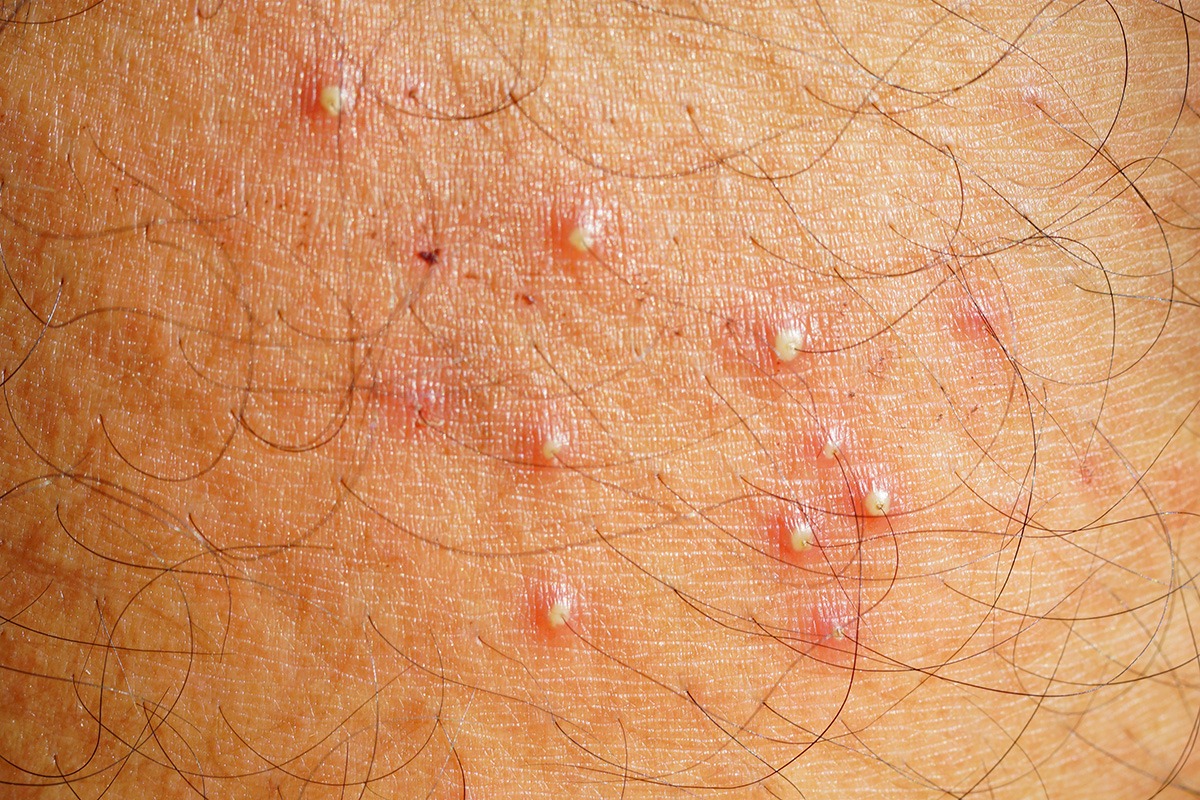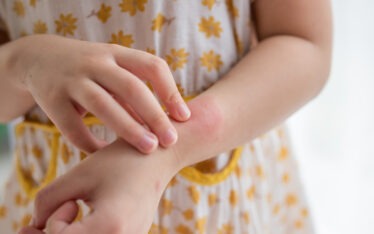Folliculitis vs. Ingrown Hairs: How to Treat Red Bumps the Right Way

Red, itchy bumps after shaving or working out can be frustrating, not to mention confusing. Are they folliculitis or just ingrown hairs? The answer matters because the right treatment depends on the cause. Treating the wrong condition can make symptoms worse or cause new problems. Let’s break down what sets these two issues apart and how to care for your skin the right way.
What’s the Difference Between Folliculitis and Ingrown Hairs?
Both conditions involve the hair follicle, but the cause and best treatment are completely different. Folliculitis usually happens when a follicle gets inflamed or infected, while an ingrown hair occurs when the hair grows inward instead of outward. These problems can look similar, but understanding the difference is key for safe care and prevention.
Folliculitis
Folliculitis is an inflammation or infection of the hair follicle. It’s often caused by bacteria like Staphylococcus aureus, but can also result from yeast, fungi, friction, or even clogged pores. The condition can show up anywhere hair grows and often looks like tiny pimples or pustules near follicles. In some cases, it feels itchy or tender to the touch.
Ingrown Hairs
An ingrown hair happens when a hair curls back into the skin instead of breaking through the surface. This is common after shaving, waxing, or plucking, especially for people with curly or coarse hair. Ingrown hairs usually appear as small red bumps and may have a visible trapped hair beneath the skin. They can be itchy, irritated, or sore.
Quick Comparison Chart
Folliculitis and ingrown hairs can look quite similar. This quick reference chart covers the most notable differences to help you better understand what you’re dealing with.
| Feature | Folliculitis | Ingrown Hair |
| Cause | Infection or inflammation | Hair growing into the skin |
| Appearance | Red pimples or pustules | Red bump, may see hair inside |
| Common Areas | Scalp, beard, chest, thighs | Face, neck, bikini line, legs |
| Contagious? | Sometimes (bacterial or yeast) | No |
| Triggers | Hot tubs, shaving, tight clothing | Shaving, waxing, curly hair |
So, why does this matter? Folliculitis sometimes requires antibiotics or antifungal care, while ingrown hairs usually respond to gentle self-care. Misidentifying one for the other can delay healing or make irritation worse.
What Causes Folliculitis and Ingrown Hairs?
Different factors trigger each condition, but both can flare up after shaving or activities that irritate the skin. Knowing the “why” behind your bumps helps you prevent them in the future.
Folliculitis Triggers
Understanding what sparks folliculitis can help you avoid flare-ups. These triggers are common culprits:
- Staph bacteria or other microbes
- Yeast or fungal infections
- Tight or occlusive clothing that traps heat and sweat
- Repeated friction from workout gear or rough fabrics
- Certain medications or shaving habits that damage the follicle
Warm, damp environments are ideal for bacteria and yeast to thrive, which is why folliculitis is common after workouts, hot tub use, or shaving without proper hygiene.
Ingrown Hair Triggers
Ingrown hairs are usually linked to hair removal habits and friction. Here are some of the most frequent causes:
- Improper shaving technique, like shaving too close or against the grain
- Naturally curly or coarse hair that bends back into the skin
- Tight clothing that rubs against shaved areas and pushes hairs inward
- Waxing or plucking, which can distort the hair follicle
If you’re prone to ingrown hairs, these triggers can make them more frequent, especially in high-friction zones like the bikini line or beard area.
How to Treat Folliculitis the Right Way
Treatment depends on the cause and severity. While mild cases often improve with self-care, persistent or widespread bumps may need prescription care.
Mild Cases
In mild cases, your dermatologist may recommend:
- Wash gently with an antibacterial or antiseptic cleanser
- Apply a warm compress to ease discomfort and draw out bacteria
- Avoid shaving, tight clothing, or anything that irritates the skin until healed
H3 – Moderate to Severe Cases
In more severe cases, further treatment may be necessary. This might include:
- Topical or oral antibiotics for bacterial infections
- Antifungal creams for yeast-related cases
- Prescription antiseptic washes (such as chlorhexidine) to reduce bacteria
- Dermatologist evaluation for recurrent or resistant cases
While you might be tempted to, avoid “popping” pustules. This can worsen infection and cause scarring. When in doubt, see your dermatologist for a tailored plan.
How to Treat Ingrown Hairs Properly
Ingrown hairs are usually safe to manage at home. Of course, it’s important to do it correctly and gently. If an ingrown hair becomes painful, looks infected, or turns into an abscess, it’s time for professional help.
Do’s
- Apply warm compresses to soften skin and encourage the hair to emerge
- Gently exfoliate with a mild scrub or chemical exfoliant like salicylic acid
- Use sterilized tweezers only if the hair is visible (never dig under the skin)
- Let the hair grow out naturally if possible
Don’ts
- Don’t pick or squeeze bumps—this raises the risk of infection or scarring
- Avoid shaving until the area heals
- Skip harsh, heavily fragranced products that can further irritate skin
When to See a Dermatologist
Both folliculitis and ingrown hairs usually respond to home care, but sometimes, bumps point to something more serious. Contact your dermatologist if:
- Bumps spread, become painful, or fill with pus
- Symptoms last longer than a week
- The area darkens, scars, or re-inflames repeatedly
- You notice signs of an infection, like severe swelling or fever
- You’re unsure whether it’s an ingrown hair, folliculitis, or something else
A dermatologist can confirm the cause, rule out abscesses or other conditions, and recommend targeted treatments that prevent recurrence.
Prevention Tips for Both Conditions
A few proactive steps can keep bumps from coming back. While small, these changes to your routine can make a big difference in keeping your skin clear and comfortable.
For Folliculitis
- Shower after workouts or sweating to remove bacteria
- Use an antibacterial wash if you’re prone to flare-ups
- Wear loose, breathable clothing to reduce friction
- Clean razors thoroughly and avoid reusing disposable blades
For Ingrown Hairs
- Shave in the direction of hair growth, not against it
- Switch to single-blade razors or electric clippers to avoid cutting too close
- Exfoliate 1–2 times a week to keep follicles clear
- Moisturize to soften skin and reduce irritation after shaving
The Bottom Line: Don’t Ignore Persistent Red Bumps
If you’re tired of dealing with painful, itchy bumps—or you’re unsure whether it’s folliculitis, an ingrown hair, or something more serious—it’s time to get answers. At Clarus Dermatology, we provide expert evaluations and treatment plans to address the problem and reduce the risk of future flare-ups.
Don’t guess. Feel confident about your care and your skin. Contact us today to schedule an evaluation.
Schedule a Skin Evaluation Today
Frequently Asked Questions
Can folliculitis turn into an abscess?
Yes. When folliculitis goes untreated or becomes more severe, the infection can spread deeper into the skin and develop into an abscess, which may require drainage. At Clarus Dermatology, we recommend getting evaluated early to prevent complications and ensure the safest, most effective treatment plan for your skin.
How do I know if an ingrown hair is infected?
Watch for signs like increased redness, swelling, tenderness, warmth, or the presence of pus. These indicate an infection that won’t resolve with home care alone. If you notice any of these symptoms, Clarus Dermatology can provide treatment to clear the infection and reduce the risk of scarring or further irritation.
Is folliculitis contagious?
Certain types of folliculitis caused by bacteria or yeast can spread through shared towels, razors, or close skin contact. Practicing good hygiene and avoiding shared personal items can lower your risk. If you suspect folliculitis, our team at Clarus Dermatology can confirm the cause and recommend the right treatment to prevent spreading.
What’s the fastest way to get rid of ingrown hairs?
The best approach is gentle care: warm compresses to soften the skin and mild exfoliation to help release the trapped hair. Avoid digging or picking, which can cause infection or scarring. For stubborn or painful ingrown hairs, Clarus Dermatology offers safe, effective options to address the problem and support healing.


